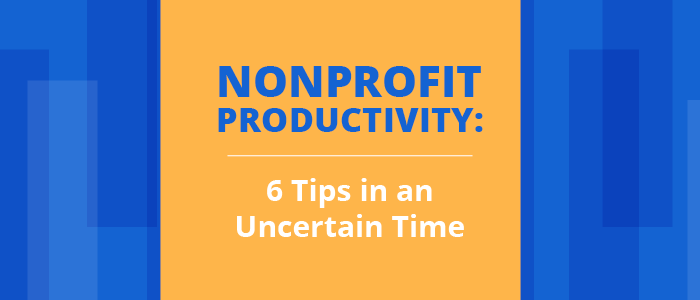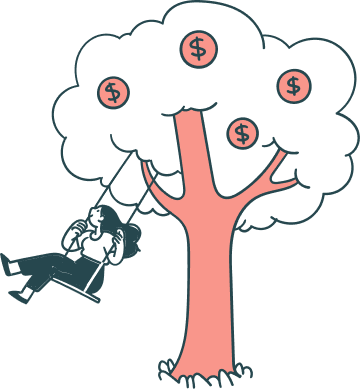So much goes into running a nonprofit organization on a day-to-day basis. Between managing team members, recruiting volunteers, raising necessary funds, and keeping daily operations in order, you’ll always have something to do. Not to mention when a global pandemic comes through and shakes everything up! So how do you make sure it all gets done?
As a nonprofit professional, you likely have limited time, money, and resources at your disposal— which is why it’s so important that you make the most of what you do have! Whether you’re a brand new nonprofit or a well-established organization, maintaining high levels of productivity within your organization, even in uncertain times, is the key to finding lasting success.
Let’s walk through 6 top tips to maximize your team’s productivity:
- Establish time tracking practices.
- Streamline donor processes.
- Digitize everything.
- Use effective tools.
- Take time to research.
- Maintain a reliable team.
With these strategic practices in hand, you’ll be on track to becoming the most efficient organization possible. Are you ready to get started? Let’s jump in!
1. Establish effective time tracking practices.
In order to use your time most efficiently, it is essential to first understand where all your time is going. Many businesses and corporations use time tracking to manage their employees, but effective time tracking practices can be beneficial to nonprofit organizations as well!
Online timesheets can even take you a step further by providing key insights into project budgeting and employee performance, all in a neatly organized digital format. And as a bonus, you can effectively manage employees remotely— to make the most of a work from home situation if need be.
These are just a few types of information you can gather with the adoption of timesheet software specific to nonprofits:
- Distribution of an individual’s time.
- Accurate costs of projects and tasks.
- Prioritization of daily tasks.
- Insurance of employer compliance.
- Which individuals’ time goes to which grants.
Accurate time tracking processes take a lot of the guesswork out of running an organization, and time tracking tools should be your key resource when it comes to boosting productivity.
2. Streamline key donor processes.
When you think of nonprofit productivity, you may be focused on your own staff. However, it’s important that you don’t forget about that of your donors in the process. When you respect the valuable time of your supporters, they’ll be more likely to stay engaged with your organization and ultimately make more gifts in the future.
Try implementing the following strategies to save donors’ time:
- Mobile optimization: With a target audience that is constantly on-the-go, it’s crucial that you keep a focus on the mobile-friendliness of your website, donation pages, and messaging. When you meet your donors where they are, they’re more likely to follow through!
- Pledge donations: While traditional donation forms can require a ton of donor information and, as a result, time to complete, pledge campaigns are designed to be quick and easy. The faster the process, the more donations are completed.
- Improving user experience: Make sure you have a well-designed website to better engage with your donors and provide a user-friendly experience. With descriptive navigation and clear calls-to-action, supporters will know exactly what you’re asking of them without extra confusion and difficulty.
Keeping the donor in mind can boost your team’s productivity by allowing for more time to be spent elsewhere, rather than troubleshooting widespread issues and mundane user experiences. And maintaining effective fundraising strategies is crucial in the midst of a pandemic, in order to retain necessary funds and keep your doors open.
3. Digitize your nonprofit operations.
In today’s digital age, it’s important to get as much of your operations online as you can. Digitization of your nonprofit records offers benefits such as improved organization, boosted security, integration with other tools, and more accurate and accessible records at your fingertips.
For example, these three key elements involved in running a nonprofit can increase productivity and save you time when you take them online:
- Donations: You don’t have to worry about cashing checks and keeping track of cash donations when you transition to online donation forms. All donations go to the same place with minimal effort!
- Receipts: Automated online donation receipts come in handy during tax season when you don’t have to count up all your totals to generate reports and fill out endless forms. You can easily pull records of all your online donations in minutes!
- Correspondence: Can’t remember if you thanked that last donor? With digitization and automation, you don’t have to think too hard about it— your donor relations software did all the hard work.
There’s a reason the world is continuously shifting towards digitization. It makes everything easier! Be sure to keep up with your nonprofit operations by bringing them into the digital age as well, and be prepared for any unwelcome surprises.
4. Use effective tools to get the job done.
You might try to save money by completing as many processes manually as possible. However, time is money! Investing in the right tools is essential to managing daily operations and growing your organization.
Instead of using handwritten spreadsheets that are time-draining and prone to error, explore some of the best nonprofit software solutions on the market. Streamline processes such as:
- Communication and marketing
- Accounting and finances
- Data management
With the right tools, you’ll be able to bring your nonprofit to the next level without being held back by the limitations of human capabilities, time restraints, and even global pandemics!
5. Take time to research prospects and strategy.
Slowing down and taking the time to research is crucial to have the background knowledge necessary for a successful organization. Specifically, when it comes to your fundraising strategy, you can reduce time wasted targeting donors with little to no potential.
Prospect research is the key to informing your fundraising plan and reeling in major gifts. The three major elements of prospect research include:
- Affinity to give: Learn more about potential donors and their connections to organizations like yours. If you know an individual has strong feelings of support toward your mission, they’ll be more likely to make a charitable gift to your nonprofit.
- Ability to give: A donor’s ability to give refers to their current financial status, and how much they reasonably could give to your organization. This is typically determined through an analysis of donation history, real estate ownership, and business affiliations.
- History of giving: Researching a donor’s charitable history is a great way to get a feel of their likelihood to donate. You can find out whether they tend to give, where they give to, average gift sizes, and more!
Click here to learn more about leveraging a donor’s affinity to give with prospect research and how that can boost your organization’s fundraising revenue— and save you valuable time!
6. Maintain a reliable team of staff and supporters.
If your organization is run by one or two people trying to do it all, you’re not going to have much room for growth. Boost your organization’s potential by involving a wide range of individuals with various skills and opportunities.
Make sure you’re adding on and expanding your team to include a solid group of:
- Paid staff members
- Board of directors
- Dedicated volunteers
Especially for smaller and growing nonprofits, you might not have the budget to add on a whole slew of new employees. That’s where volunteers are your best resource out there! Find out how to recruit and retain the best help with this comprehensive volunteer management guide from Double the Donation.
Be sure to find and keep a dedicated team that is willing to stick with you through the ups and downs that come your way!
Improve internal workflows and set yourself up for success by tracking your time-saving progress. With effective time tracking practices, you’ll be able to visualize your team’s boosted productivity and time management skills with timesheet software and reporting features. For example, check out ClickTime’s 80+ time tracking reports available to easily recognize all the time you’ve saved.
With these key productivity tips, you’ll be well-equipped to handle everything that comes your way in the most effective manner possible. Best of luck!

Ernest Cheng is a San Francisco-based marketing professional who focuses on technologies that drive performance. He is currently the Head of Marketing at ClickTime, an award-winning time tracking platform for nonprofits, billable professionals, and growing businesses in over 65 countries.



